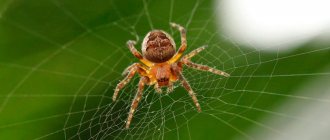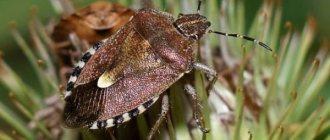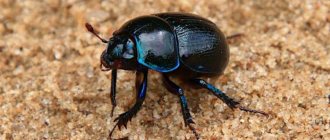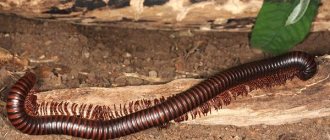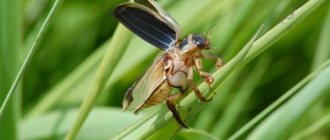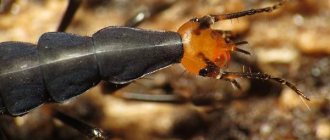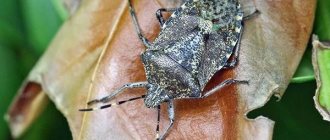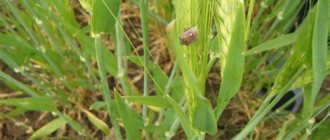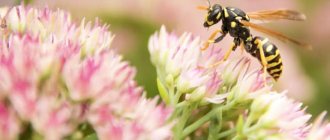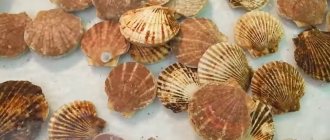⭐ ⭐ ⭐ ⭐ ⭐ █▬█ █ ▀█▀ Unfortunately, not only scientists are interested in the characteristics and varieties of bedbugs. And all because everyone can meet these insects right in their bed. House bugs are a common problem that many people experience. Among them there are even conscientious housewives who cannot find crumbs at home.
Domestic individuals are famous for hunting at night the owners of their homes. After their nightly activity, clear evidence is observed on the body that the hunt was successful.
But is it only within the apartment that one can suffer from bedbugs? In this article we will look at what types of bedbugs there are, where they are found and what harm they can cause to people.
Classification of bedbugs (All about bedbugs)
Let's start with the general classification. The habitat, lifestyle and appearance of representatives of the numerous family of bedbugs are very different from each other. Based on these differences, the following groups are distinguished:
- House pests.
- Species living in nature.
- Bedbugs are helpers.
Not all types of bedbugs cause harm to humans.
Some are able to help with gardening. Others do neither harm nor benefit. In a word, everything is quite individual. To understand all the intricacies, we will dwell on the different types in detail. Request a call
Parasitic bugs
In the Hemiptera family there are species of bedbugs that cause particular concern and trouble for people. Adults feed on the blood of humans and warm-blooded animals. Scientists count several dozen species of domestic bloodsuckers. They have the following characteristic features: a small, flat body, enlarging several times after saturation. Wings are absent as unnecessary, since the insect is able to very quickly cover significant distances, even climb onto the ceiling and from there glide towards its prey.
House bugs multiply quickly and can infest the entire house, depriving people of a quiet life. They are nocturnal, but sometimes attack their prey during the daytime. At the first signs of the appearance of parasites in the apartment and the discovery of their places of accumulation, it is necessary to immediately take measures to completely destroy the bedbugs. In Moscow and other cities there is a huge amount of necessary drugs used in domestic conditions to get rid of bed bloodsuckers.
Bed bugs have their closest relatives living in countries with hot climates. This is a stinging bug that looks like its relative. He moves slower, jumps slightly, and cannot stand the cold. Insect bites cause an allergic reaction and are more noticeable in their strength. The most dangerous bug for humans is the triatomine bug, which lives in Latin America. Its bite can cause anaphylactic shock and it is also a carrier of the deadly Chagas disease. Photos of different species of bedbugs posted in the article will allow you to carefully examine all representatives of the hemipteran family.
Bugs (Heteroptera) are a suborder of insects belonging to the order Hemiptera. About 40 thousand species of such arthropods are known.
Some existing varieties of bedbugs are very small in size, but representatives of most species can be clearly seen even without a magnifying glass or special devices.
Classification of bedbugs
The habitat, appearance and lifestyle characteristics of representatives of the bedbug family differ markedly. Based on these differences, several main groups are distinguished.
At the same time, the existing varieties of domestic bugs are not too numerous compared to such insects living in nature.
House (bed) bug
Bed bugs (Cimex lectularius) are common obligate synanthropic blood-sucking insects. Such ectoparasites of warm-blooded animals and humans feed on blood.
The insect has a flattened body 3.0-8.4 mm long, but males are usually smaller than females. Body color ranges from dirty yellow to dark brown.
At the front edge of the head is a proboscis used for piercing tissue and sucking blood. The geometric features and flexibility of the segmented body make the bug weakly vulnerable to mechanical methods of destruction.
Stinging bug
One of the varieties of the common bed bug has practically no differences in appearance, but is a more dangerous representative of arthropod parasites for people and warm-blooded animals.
Traces from a stinging bug bite are always more pronounced, and redness on the skin can easily reach a five-centimeter diameter, and has the shape of a large blister.
All skin reactions are accompanied by severe itching and acute allergies, reminiscent of hives.
Soldier bug
The red bug (Pyrrhocoris apterus) is a common terrestrial bug of the red bug family. The average size of an adult individual of this species varies between 9-11 mm.
Large concentrations of soldier bugs are found in sunny areas, near stumps and tree trunks, near fences and woodpiles. Insects overwinter in dense colonies, under fallen leaves.
Fallen plant seeds and dead invertebrate animals are used as food. Signs of cannibalism are often observed in colonies.
Green shield bug
The green wood bug (Palomena prasina) belongs to the family True bugs and is a relatively large bug with a body length ranging from 11-16 mm. The color is uniform, bright green.
The arthropod settles on the most herbaceous plants, various deciduous trees and berry bushes, preferring raspberries and currants.
The shield eats food of animal and plant origin. Sometimes the insect harms cereals.
bug bug
The European tortoiseshell (Eurygaster integriceps) belongs to the genus Eurygaster and the family Scutelleridae.
The body length of an adult is 10-13 mm. In such an insect there is no closure of the zygomatic plates in front of the clypeus.
Adult insects spend the winter in forest belts or gardens under fallen leaves. The emergence of the bug from the wintering area occurs from March to May, when the average daily air temperature reaches 12°C. The insect is most active during the daytime.
forest bug
Forest insects are ideally camouflaged in the color of green foliage and tree bark, so in natural conditions there are individuals that are colored in all shades of green and brown.
The body of the forest bug has a specific wide and flattened shape, resembling an irregular pentagon. Such insects live mainly in forests, but can be found in their surroundings.
In winter, forest bugs go into what is called hibernation.
Horsefly bug
Horseflies (Miridae) belong to the family Hemiptera and the suborder of bugs. The insect is medium or small in size, and the body length of an adult can vary from 2-3 to 10-11 mm.
The insect's body is characterized by the presence of relatively soft integuments and is distinguished by an almost round or noticeably elongated shape. Most representatives of this species are herbivorous bugs, but some are zoophytophages and predators.
Lined bug
The striped graphosoma (Graphosoma lineatum) belongs to the family of true shield insects, and the body of such a medium or large-sized insect has a noticeable external similarity with the colors of the uniform of the Vatican guards.
The body length of an adult reaches 10-11 mm. The body color of the bug is red, with several longitudinal black stripes.
The scale insect is found in the middle zone and lives in Central Asia, where it feeds on the seeds of umbrella plants.
Alder brood bug
The wood brood bug (Elasmucha fieber) is a typical representative of the Tree Scutellidae family. During the summer breeding season, females of such insects settle on the foliage of alder, birch or currant trees.
Resembling a grayish butterfly, the hen bug feeds on plant foods, and the main feature of such an insect is the presence of a characteristic taste that currants and raspberries receive after the arthropod uses their juice.
Common water strider
The swampweed (Hydrometra stagnorum) belongs to the hemipteran insects of the genus Hydrometra and the family of rod-shaped water striders (Hydrometridae).
Water striders inhabit ponds and ditches, as well as bodies of water with slow currents.
OLYMPUS DIGITAL CAMERA The body length of an adult insect is 11-13 mm. The body of the water strider is thin, dark grayish or black, with a relatively long head. Adults, in search of prey in the form of water fleas and mosquito larvae, move rather slowly along the water surface.
Water scorpion
The common water scorpion (Nepa cinerea) belongs to the family Nepidae. The insect is a typical inhabitant of many silted fresh water bodies in Europe, Northern Asia and Africa.
The insect is distinguished by a flat and wide body, which has two respiratory tubes at the end of the abdomen. The length of an adult varies between 17-25 mm. The head is small, triangular, with a pair of small eyes and a sharp proboscis.
Garden
Widespread garden bugs is a common, collective name that unites all stink bugs living in vegetable gardens and orchards. Representatives of garden bugs include several dozen species that differ in body shape and color.
The so-called country bugs live on fruit and berry plants, and some pests use the foliage of wild plants as food, but if necessary, they easily switch to garden or vegetable crops.
Homemade
Bedbugs of various species that live at home are representatives of the order Hemiptera. Such insects do not fly, but are able to move quickly enough around the apartment, preferring places near people.
The only source of nutrition for parasites is the blood of people and warm-blooded animals.
What are bedbugs?
Today, approximately forty thousand species that belong to almost sixty families are known and well studied. Among bugs, there are commensals and inquilines, and representatives of some families prefer to create associations with anthills and ants.
Morphology
Most bedbugs have scent glands, the openings of which are located in adults in the lower part of the thoracic region, between the first two pairs of legs.
The discharge from such glands has a characteristic odor that is unpleasant to humans.
It is assumed that its purpose is to scare off enemies, and possibly act as a pheromone. The secretion is represented predominantly by aldehydes, for example those close to CH3-(CH2)2-CH=CH-CHO, and resembles pheromones in composition.
Some species are characterized by caring for offspring, as well as some signs of subsocial behavior. The mouthparts of arthropods are of the piercing-sucking type.
Bedbugs can be predators, parasites (in particular hematophagous) and herbivorous insects. There are often types of bedbugs that have a mixed type of diet and are also distinguished by the presence of signs of cannibalism.
Stages of development
Bedbugs are insects that have a complete metamorphosis. The life cycle is represented by three main stages. The female lays eggs, from which larvae hatch and quickly turn into adults.
They lay eggs, after which the insect’s life cycle begins a new phase.
Due to the very short time it takes for bedbugs to fully develop, a colony of such insects is capable of increasing its total number with incredible speed.
Features of nutrition and reproduction
The type of food depends on the species characteristics of the bedbugs. Most arthropods belong to the category of herbivorous insects that are harmless to humans, but predators and individuals with a mixed type of diet are also found among bugs.
Many bedbugs lay eggs exclusively in secluded places, but species are known that bear their offspring directly on themselves. The development of the larva takes place in five stages, and the time the insect matures takes from a couple of weeks to one and a half or two years.
Habitats and causes of appearance
There are several reasons for the appearance of bedbugs in a home, but the main ways in which parasites enter human housing include natural migration through ventilation systems, pipe risers or other communications, the introduction of insects on clothing, and the purchase of used items or furniture infested with parasitic arthropods.
Why are they dangerous?
A very large part of hemipterans belong to the category of pests and are capable of causing significant damage to various agricultural plantings.
Blood-sucking species not only cause itching and allergic reactions, but are also carriers of many diseases dangerous to humans.
How long do they live?
The lifespan of bedbugs varies depending on the characteristics of the insect species, as well as basic environmental parameters and the availability of sufficient food. For example, bed bugs live on average 10-12 months.
How to kill bedbugs
To destroy domestic and natural bedbugs, various means are used, which differ in price and composition, are produced in a form convenient for use and are highly effective.
The drug “Dichlorvos-neo” is an insecticidal agent in the form of an aerosol. The advantages are presented by ease of use and effective composition, affordable price, lack of odor, and harmlessness to people.
Disadvantages: the drug is not able to destroy larvae. The average cost is 92 rubles.
The preparation “Executioner” has a slight chemical odor, dissipates quickly and is very easy to dilute for surface treatment. The advantages are high efficiency, low consumption, affordable price and ease of use. Disadvantages: need to purchase a spray bottle. The average cost is 102 rubles.
The drug “Karbofos” in powder form is used for dilution with water, is distinguished by the presence of malathion in its composition and is highly effective.
The advantages are represented by affordable price, ease of use and speed. Disadvantages: high level of toxicity, strong and long-lasting odor. The average cost is 98 rubles.
The drug “Fas” is an insecticidal agent in tablets that is economical and versatile. The advantages are represented by an affordable price, easy dissolution in water, simple use and long-lasting action.
Disadvantages: high toxicity. The average cost is 28 rubles.
The insecticidal preparation “Clean House” is economical and is available in 50 gram bags and in aerosol form. The product is perfect for treating any hard-to-reach places.
The advantages are represented by reliable protection against parasites and a highly effective composition. Disadvantages: high toxicity. The average cost is 38 rubles.
What else do you need to know?
When independently choosing a method of control and the type of means for destroying household or natural parasites, you should pay special attention to several of the most important factors.
The product should not contain too many chemicals that may have a negative effect on the health of people or animals. After treatment, the smell should disappear as quickly as possible.
The method of application of the product is of no small importance. Some drugs are ready for immediate use, while others may require preliminary dissolution, which makes their use somewhat more difficult.
It should be noted that some of the most budget-friendly products do a good job of killing bedbugs, so cost is not always the determining factor.
Beneficial bugs
Some beneficial predator bugs are bred commercially to replace toxic pesticides. The bug of the horsefly family (Macrolophus) has proven itself to be excellent, capable of producing about three thousand whitefly eggs or larvae in its lifetime.
In closed ground conditions, such an insect fights aphids, thrips and spider mites. Macrolophus is used in greenhouses with eggplants and tomatoes, cucumbers and peppers, as well as some ornamental plants.
The perillus bug preys on the offspring of the Colorado potato beetle, a variety of butterflies and leaf beetles. Predators from the family of flower bugs feed on beetles and thrips, spider mites and aphids, egg-laying butterflies, as well as whitefly larvae, while the prey of the podisus bug are harmful butterflies and beetles.
The use of such beneficial insects on the site is harmless to humans and animals, and also helps to obtain an environmentally friendly and high yield.
How do bedbugs appear in an apartment?
The sanitary condition of a living space does not affect its attractiveness to bedbugs. Rapidly multiplying parasites are equally willing to move into not only completely filthy barracks, but also luxury apartments.
The main entrance gates of a private house or city apartment for any bedbugs are sockets, ventilation ducts, water supply and heating pipelines, windows and doors.
House (bed) bug
From the name, a lot becomes clear: the species lives exclusively in places where humans live, and pays special attention to his bed. The place where a person sleeps is an ideal hunting field. To clarify this thesis, it is necessary to consider the mechanism of attack on a person.
Domestic bugs feed exclusively on the blood of humans or animals. At night, the parasite climbs onto the victim’s skin and uses its sharp beak to pierce the skin. At this moment, the pest’s saliva is injected into the human blood, which contains a certain substance that has an analgesic effect. Thanks to this, the person continues to sleep peacefully, feeling practically nothing, while the bug is saturated with blood. Doing the same thing with an awake victim would be more difficult. Once satiation occurs (this can take up to 15 minutes), the individual looks for a secluded place to begin digesting food.
Advice from a specialist from the Eco-Processing service: Do not, under any circumstances, put up with the presence of bedbugs in your home. The longer action is not taken, the more difficult it is to solve the problem in the future, as the population increases every day. The earlier disinfestation is carried out, the greater the chance of long-term results.
A house bug looks like this: Body length, depending on the age of the individual and the degree of satiety, can range from 3 to 8 millimeters; Interestingly, females are usually longer than males. The color of the body is also not the same and varies from light brown to brown. The insect's proboscis can be seen with the naked eye. It is with its help that the parasite pierces the skin. The hungrier the pest, the more mobile and elusive it is, which cannot be said about a well-fed individual.
Bedbugs are parasites
Parasitic type bedbugs are blood-sucking insects that settle closer to people. The danger is that they can carry infectious and viral diseases.
Bed sheets
Bed bugs are the main species of house bugs that feed exclusively on the blood of mammals. They often live in the sleeping areas of humans and pets. When in danger, they emit an unpleasant bug odor.
Cimex lectularius
It is a wingless, flat-shaped insect. Adults reach a size of up to 8 mm. The exoskeleton of a hungry parasite is dirty yellow or brown. After saturation with blood, it changes color to black or dark red.
The eggs of the parasites resemble small grains of rice - up to 1 mm in length. Painted white. Due to the content of a specific secretion produced by internal glands, when crushed, eggs emit a sharp, unpleasant odor.
Attention! Types of bed bugs appear regardless of the sanitary condition of the apartment.
Cimex adjunctus
Alternative names: white, mouse bug. It feeds on the blood of bats and rarely lives in human bedding. In appearance it does not differ from Cimex lectularius. The length of the body is from 3 to 8.5 mm, depending on the degree of saturation of the parasite with blood. Females are larger than males. A distinctive feature of a mouse bug is the presence of white hairs near the head. Insects do not have fore or hind wings.
Cimex hemipterus
The bug Cimex hemipterus is a blood-sucking insect. Parasites prefer to settle closer to people. They actively displace the bugs Cimex lectularius, with which they are similar in appearance. Distinctive features are thinner, elongated limbs and a less rounded body. With the onset of dusk, the activity of parasites decreases. They are highly resistant to chemical insecticides.
Oeciacus
An alternative name is the swallow bug, which parasitizes the bird species of the same name. The rounded body is painted white. Distributed in the European part of Russia.
Triatomine bug (Triatominae)
Belongs to the family of carnivores and is nocturnal. The insect has an elongated body, about 2 cm long. The exoskeleton is black or gray, with orange or red spots on the sides. Adults have hard wings and 3 pairs of limbs. On the cone-shaped head there are long antennae and a piercing-sucking mouthparts. The parasite's diet includes only the blood of mammals and birds. The proboscis is sensitive to infrared radiation.
An alternative name is the kissing bug, because its mouthparts are not capable of piercing the thick skin of the body. To suck blood, the insect bites a person in the soft tissues of the eyes and lips.
Important! The triatomine bug is one of the most dangerous types of parasite, as it can infect humans with Chagas disease or American trypanosomiasis.
Chicken bugs
The insects resemble chicken mites in appearance. They are brown in color and have a flattened body. They swell from drinking blood and change color to black or burgundy. They are nocturnal and hide in hard-to-reach crevices during the daytime. You can suspect the presence of parasites in birds by skin irritation and redness. Bedbug bites cause severe itching and pain, which is why the bird begins to peck at the affected area and injure itself with its claws.
Stinging bug
This is a close cousin of the bed bug. Few are able to distinguish them with the naked eye, because even in appearance they are very similar to each other. However, the stinging bug is more dangerous to humans. Traces from stinging bug bites are more pronounced: redness can reach 5 centimeters in diameter and take the form of large blisters. This is accompanied by severe itching, which is an acute allergic reaction similar to hives. This type of bedbug is also different in that it moves much slower than a bedbug.
House bugs
Parasitic species of hemiptera have chosen humans as hosts. They settled in houses where they found favorable conditions and a constant source of food. Not everyone knows what house bugs look like. Insects have a flattened oval body. The dimensions of the imago are 4.5-6 mm, the larvae are 1-4 mm. The color is yellowish or red-brown. The oral apparatus consists of a proboscis and spiny bristles. Insects are wingless and move with running legs.
Information. After sucking blood, bedbugs double in size and turn red. The body takes on a spherical shape.
Photo of a house bug
The bed bug family (Cimicidae) consists of more than 70 species. In total, its representatives are parasitic, sucking blood from people, small mammals, birds and bats. Insects are cosmopolitan and have spread throughout all countries. Synanthropes are active at night when people are sleeping. They wait out the day in narrow crevices of walls and furniture, into which they penetrate due to the structure of the body. Adults migrate in search of new feeding sites; they can move to a neighboring apartment or building. For complete information about synanthropic parasites, see the article “Bed bugs: appearance of blood-sucking bugs, and what harm can they cause to health?”
Types of house bugs
In Europe and Russia, 3 types of parasites are noted:
- Cimex lexctularius is the most common species. The full development cycle is completed in 30-100 days. Imagoes have a well-developed sense of smell; they accurately find the victim. They prefer to bite children due to the proximity of blood vessels to the skin. An adult parasite is capable of starving for 1 year; nymphs without food stop developing. The bug emits a specific smell, which some people characterize as cognac.
- Cimex pipistrelli - representatives of the species were seen on bats in the Moscow region.
- Oeciacus hirundinis - the swallow bug parasitizes birds. Distribution area: European part of the country. After swallows leave their nests, insects can sneak into the house and feed on people. Ectoparasite bites cause severe itching and rash. Viral and bacterial infections are possible.
The species Cimex hemipterus is found in tropical regions of Africa, South America and Asia. In appearance it is no different from a bedbug, but the insect's saliva causes a severe allergic reaction. A blister appears at the site of the bite, and a burning and itching sensation is felt.
Bed bugs are active at temperatures of 25-30°. They feed about once a week, the nymph sucks out 0.5 ml of blood, and the imago sucks up to 7 ml. Insects leave a whole trail of bites on the body. Injecting saliva with an anesthetic into the wound allows them to remain undetected. Ectoparasites negatively perceive changing climatic conditions. At a frost of -17-20° they live for about a day; heat of 45° kills them in 45-50 minutes. In favorable conditions, life expectancy is 12-14 months.
Triatomine bugs
Representatives of the carnivore family live in Central America. Insects do not settle in apartment buildings; they prefer trees and animal burrows. They also live in rural areas, choosing adobe huts. Blood-sucking species are carriers of the dangerous Chagas disease. When bedbugs bite a person, they deposit excrement infected with pathogenic microorganisms near the wound. During the scratching process, they penetrate into the blood. The body of insects is pear-shaped, size 15-34 mm. Bites occur on the eyelids and lips; for this feature the parasite is called the “kissing bug.”
The diversity of species has provided bedbugs with ample opportunities for survival. Insects have adapted to life in water and on land. Pests quickly develop resistance to insecticides. People have to create new chemicals and look for effective ways to combat bedbugs.
Soldier bug
This type of insect has been known to many since childhood. All thanks to its distinctive appearance. The contrasting red and black coloring makes it look like a ladybug and always attracts attention. Moreover, these insects do not try to hide at all. They live in the wild, beginning to appear with the first warmth of spring. They can be observed in large numbers on the sunny side of stumps, trees, and fences.
The harm caused to people by these pests is not direct, but indirect. Soldiers significantly interfere with the normal development of garden plantings: they eat young plant leaves and garden plantings. In addition, insects have a weakness for fruit pulp. For example, grapes quite often end up being sucked out by soldiers.
Green shieldweed
Another inhabitant of the wild with interesting features. Firstly, it is famous for its ability to emit a foul odor. Secondly, the shield bug is able to change its color, adapting to the environment. That is, in the summer, insects are predominantly green, in early autumn they are brown (to match the color of bright falling leaves), and by late autumn the individuals acquire a brown color. This skill perfectly camouflages insects in nature.
Like the toy soldier, the stink bug causes significant damage to garden crops: raspberries, gooseberries and many others. First, the fruits on which pests begin to parasitize begin to smell unpleasant, and soon they become completely suitable only for throwing away.
Appearance and features
Although shield bugs are divided into many species that differ greatly from each other, they have several characteristic features:
- Size up to 12-15 mm.
- 1 pair of multi-segmented antennae that perform the functions of sensory organs.
- The mouthparts are of the piercing-sucking type with a proboscis and very small jaws, visible only under a microscope.
- An oval, flat body, covered on top with a hard, leathery membrane.
- Rectangular protrusions located in the cephalothorax area, giving the body the shape of a shield.
- 3 pairs of multi-segmented paws, consisting of 3-5 elements.
- The color is bright green or yellowish-brown.
- Not everyone has wings, but most do. They are usually paired: the front ones when folded look like a chitinous shell, the rear ones are larger, thinner and transparent.
An interesting feature of the beetle is that its color can change depending on the time of year. During the summer months, the insect turns green among the lush foliage. With the arrival of autumn, brown, black or yellow spots appear on its body.
bug bug
The species acquired its nickname due to its bizarre coloring: the patterns and color on the back of the individual are very similar to the coloring of a turtle. Turtle bugs are malicious pests of cereal crops. Individuals that have survived the winter begin to attack young shoots, and the newly emerged larvae begin to destroy the cereals themselves. After such an attack on plants, it becomes completely impossible to produce flour from them.
The fight against turtles is a pressing issue for both large farming organizations and private gardeners. Extermination measures involve the use of insecticides.
forest bug
Every year, with the onset of warm weather, forest bugs begin to annoy gardeners, attacking plantings. Like the green stink bug, the forest bug has a sharp, unpleasant odor, as well as a rather unassuming appearance. The color is not only green, but also brown. This is a very dangerous garden pest, as almost any plantings suffer from it: fruits, vegetables, berries. Parasites lay eggs directly on crops, securely attaching them to the surface of the plants. The larvae that emerge from the eggs immediately begin to destroy the plant on which they appeared. This has a detrimental effect on crops.
What do house bugs look like?
Many have heard about such bloodsuckers, and those who have had to deal with them know what they look like. It is difficult to spot an insect for several reasons. Firstly, it is very small. Secondly, it is nocturnal.
The body length of a hungry bug is only 3 mm. The body is flat and almost transparent, with a brownish tint. Consists of separate segments that are able to expand as food arrives. Thanks to this, a well-fed insect changes shape - it becomes round and increases to 8 mm. Look at the photos and videos to see what home bed bugs look like
Pierces the skin with a proboscis. The small jaws have two canals. The first is for the injection of poisonous saliva with an analgesic. Thanks to this, the person does not feel the bites, and the insect eats calmly. The second one is intended for eating.
The body is covered with villi and protected by a durable shell. It is simply impossible to crush a hungry bug, even if you press hard on it. A well-fed one can be destroyed with the slightest effort.
Females are always larger than males. In the photo the female is located at the bottom.
The behavior of a hungry and a well-fed bug is very different. The first one is very fast and agile. Able to climb onto the ceiling and from there dive onto a sleeping person. A well-fed insect is slow and clumsy.
Body color depends on the time of food consumption. The hungry bug is dirty yellow in color. Recently fed - scarlet. The dark brown color indicates that the parasite has been eating for a long time. The photo shows an insect that drank human blood quite recently.
Bedbugs amaze with their fertility. One female is enough for your home to be filled with insects in 2 weeks. In a couple of months you won't know how to get rid of them. The female lays an average of 5-12 larvae per day and 300-500 throughout her life.
The eggs are white, 1 mm long and look like grains of rice. The picture can be clearly seen in the photo.
Bedbug eggs are found in one place and are easier to detect than adults. The ripening period is 1 week. They are not afraid of temperature changes and are insensitive to most chemicals.
Immediately after hatching they are able to drink blood. To start the mechanism of maturation, the larva needs to taste blood at least once. This explains the activity of insects in the first week of their appearance. Unlike an adult bedbug, they are unable to release an analgesic when bitten. Therefore, bites are felt immediately and the bedbug can be killed quite easily.
It takes 1 month to turn into a full-fledged bug. During this time, the insect changes its chitinous shell 5 times. It increases in size and darkens. Because of their transparent color, they are often called nymphs.
See the photo for the process of turning a larva into an adult bedbug.
The larva of a bed bug leads the same lifestyle as an adult. It differs in the volume of food absorbed and the number of bites made.
The insect lives for a year or a year and a half. When the temperature drops below 18 degrees Celsius, it goes into hibernation. It exists in a hungry state for six months. During this time it turns into a transparent, flat bug. Looks like he's dead. When the temperature is optimized, it comes to life and leads a normal life. They are afraid of low temperatures from – 15 ⁰С and high temperatures – from + 49 ⁰С.
Horsefly bug
Another pest of vegetation, however, only ornamental plants fall victim to this species: chrysanthemums, roses, fuchsias and others. The main food of horseflies is flower juice. Moreover, the main damage to crops is caused precisely at the moment of piercing tissues and injecting poison. This leads to drying out of these areas, as a result of which the process of photosynthesis is disrupted. Additional damage is caused by parasite eggs: attached to the foliage, they provoke their curling and complete drying. After the horseflies finish their pest activity, the plant has curled dry leaves and a crooked stem.
Lined bug
This extravagantly colored bug is also called the Italian bug. Individuals are colored with black and red stripes and are very noticeable in nature. However, due to their similarity to Colorado potato beetles, line bugs often cause gardeners to become concerned. In reality, there is absolutely no harm from them. This is a harmless member of the bedbug family. However, sometimes they attack some umbrella plants, which does not affect garden crops in any way. If there are too many insects, for your peace of mind you can simply collect the insects spotted in the garden, and most likely they will not appear again.
Alder brood bug
This representative belongs to the family of tree shields. The insects got their name due to the fact that females choose alder to produce offspring. Females occupy the alder tree for quite a long period. First they lay eggs, then they protect them, and after that they take care of the emerging larvae. This is an interesting feature of this species: females do not leave their larvae until they can begin an independent life outside the nest. This type of bedbug also does not pose any threat to humans.
Common water strider
It’s the turn of those types of bedbugs that prefer the water element. The water strider is a prime example of this. Many have seen these weightless insects moving along the surface of the water and did not even imagine that they were looking at a type of bug. Insects easily stay on the surface of the water, moving with sharp jerks.
This happens due to the special coating of thin paws: their surface is covered with tiny hairs that do not get wet due to fat impregnation. Other insects that fall into the water become food for water striders. By autumn, water striders leave water bodies and spend the winter in fallen leaves.
Inhabitants of reservoirs
Bedbugs have not ignored water areas either.
- The nimble water strider - this type of representative of the family of street bugs can be found in any body of water. The small insect has long legs that allow it to move along the surface of the water. The water strider's movements are chaotic; it quickly changes direction. The special structure of its legs allows it to glide through the water, quickly approaching insects that have fallen into the water in order to suck out all the juices from them. In the winter, this type of street bug leaves water bodies and hides in fallen leaves.
- The water scorpion is another type of bedbug that lives in aquatic environments. This type of insect lives in shallow water, as they cannot swim at all and crawl along the bottom in anticipation of their next victim. The water scorpion breathes with the help of a special tail appendage that extends above the water.
- Gladysh. An interesting fact is that representatives of bedbugs also live in the underwater world. The smoothie lives up to its name, as its body resembles a boat, deftly and quickly cutting through the water column. It prefers ponds with standing water, but can settle in a puddle or barrel located on a personal plot. This species is capable of flying long distances at night in search of food. The bite of a street bug feels like a bee sting, but is not dangerous to humans. Smoothie can attack not only insects, but also small fish.
- The giant belostoma looks terrifying. Topping the list are giant water bugs. The front limbs of a street bug resemble the claws of a crayfish, and the victim is unlikely to escape from them. Due to its impressive size (more than 10 cm), it is capable of attacking frogs, fish and turtles. The female Belostoma lays eggs on the back of the male, who patiently bears them. This type of bedbug does not live in Russia.
- Plautus vulgaris is a type of bedbug that lives in water. It has a powerful dark green body and paddle-like, hairy legs. This type of street bugs hunts fry, insect larvae and mollusks all day long.
Water scorpion
This type of bedbugs fully justifies the formidable name, which just matches their appearance. These absolutely black insects have a flat body and six pairs of long legs, the front of which are very similar to the claws of a real scorpion. They are used to capture and hold the victim. At the back of the body there is a long tail, similar to a sharp needle, which is used for breathing when the individual dives under water.
The habitat of the water scorpion is shallow water, where it hides in the coastal thickets, looking out for its prey.
Can bed bugs be beneficial?
Answer: they can. We looked at a number of dangerous varieties and several harmless ones. However, it happens that these insects can provide some benefit.
Several species are responsible for this, which are very helpful to gardeners. For example:
- Zicron blue. These insects perform a responsible task - the destruction of the Colorado potato beetle. These predators from England have a shiny blue-green body. They hunt mainly during the day, destroying the eggs of garden pests.
- Perillus. These insects fight various parasites, including adults.
Water strider bugs
Few people know that these insects are also bedbugs.
Water striders live in water, in ponds and lakes.
The body of these insects is thin, elongated, the legs are quite long, spaced apart.
They are covered with small hairs.
With their help, the water strider can quickly slide across the surface of the water.
These bugs bite, so it is not recommended to pick them up unless absolutely necessary.
They direct aggression towards the person who irritates them, and water striders eat small bugs living in the water or on the shore nearby.
There are even more bizarre-looking bugs from the same family in nature: the water scorpion and the common scorpion. They also do not pose a major threat to people, but vice versa for the aquatic population.
They swallow careless aqua wanderers.
Below is a picture of them:
And now briefly about the most popular type of domestic inhabitants, which cause significant harm and disturbance to people.
Fighting bedbugs
Since there are not so many useful representatives among bedbugs, the fight against individual species is important for both urban residents and rural farmers. Fortunately, today there are special services that help cope with parasites both in the city and outside the city.
The important point is that modern drugs used by the services do not harm people, pets, or plantings. uses only class 4 products of low-hazardous substances. This indicates the effective destruction of parasites and absolute safety.
Harm from bed bugs
A domestic bug lives on average 12 – 14 months. Eats once a week. A bug nymph can suck up to 0.5 ml of blood at a time, and an adult can suck up to 7 ml. All bed bug bites cause itching, redness of the skin, and a rash. Moreover, a person may not notice the moment of the bite, since the parasite injects an anesthetic substance during the bite.
The danger with bed bugs is that they are difficult to get rid of. They settle in large colonies in an apartment or house and plague residents with constant bites. This leads to severe psychological discomfort. In terms of health, there is no great harm from bedbug bites. But they can cause allergic reactions. Bedbugs can also act as carriers of diseases if they migrate between rooms. In addition, blisters from bites are very itchy, scratching them can introduce an infection into the wounds, which leads to skin diseases.
Domestic bugs are sensitive to changes in living conditions. The most comfortable temperature for them is 25 – 30 degrees. With a sharp increase (more than 45 degrees) or decrease (freezing), they die. But at the same time, these insects are becoming increasingly resistant to the means used to combat them. People have to invent new compounds to chemically kill bedbugs.
Types of pest control
Disinsection - work to exterminate and control the number of insects. It comes in two types:
- Fighter. It is carried out when there is a source of infection. These could be domestic bed bugs or garden pests. In any case, emergency treatment of the object against bedbugs is required to stop the reproduction of individuals, stop their destructive activities and destroy the entire colony.
- Preventive. As a rule, such disinfestation is necessary in places with an increased risk of parasites. Based on an agreement with the head of the institution, regular work is carried out to prevent the occurrence of infection.
The cost of treating an apartment for bedbugs
| ✓ cold fog | 2 in 1 ✓ cold mist ✓ barrier protection | 3 in 1 ✓ hot mist ✓ disinfection of viruses and germs ✓ barrier protection | COMPLEX ✓ hot fog ✓ cold fog ✓ disinfection of viruses and microbes ✓ barrier protection | |
| 1 room apartment + MOP | 1800 rub. | 2700 rub. | 4500 rub. | 6200 rub. |
| 2 room apartment + MOP | 2100 rub. | 3000 rub. | 4700 rub. | 6600 rub. |
| 3 room apartment + MOP | 2300 rub. | 3200 rub. | 4900 rub. | 6900 rub. |
| 4 room apartment + MOP | 2500 rub. | 3400 rub. | 5100 rub. | 7200 rub. |
| 5 room apartment + MOP | 2700 rub. | 3600 rub. | 5300 rub. | 7600 rub. |
| MOP (separately) | 1500 rub. | 2000 rub. | 3000 rub. | 4000 rub. |
| Treatment with “premium” preparations +1500 rubles to the cost | ||||
Stages of professional pest control
Whatever types of bedbugs infest a house or garden, the procedure for their destruction will proceed according to a certain scheme:
- Preparing the object. The main preparations concern the living quarters. They must be produced by the customer himself. It is necessary to wet clean the room so that the dust layer does not interfere with the action of the insecticide, pack and hide personal items, food and dishes, and also protect the aquarium if present (turn off the air enrichment system and close the aquarium).
- Treatment. The arriving technician begins work with a visual assessment of the infestation, identifying all places where pests accumulate, as well as determining the cause of their appearance. After this, the preparation of chemical compounds and the treatment itself takes place, which lasts no more than 30 minutes.
- Final manipulations. Required to enhance the effect of treatment and avoid poisoning. It is necessary to ventilate the premises for several hours, and also wash the floor, keeping a distance of 10 centimeters from the baseboards. In addition, all work surfaces should also be wiped down.
How to determine the type of bedbug
There are two ways to determine the type of bedbugs in your apartment.
The first is to turn to professional exterminators who have enough experience to find out who is in front of them. Also, an experienced specialist in the disinfection field is always up to date with the latest news on the prevalence of a particular species in your city.
The second is to contact a specialist (entomologist), since recently scientists have been doing a lot of work to identify new species, studying the biology, morphology, and behavioral reactions of newly emerged bedbugs. An example is the scientists at the University of Florida.
In principle, even if you haven’t determined what type of bedbug lives in your home, it doesn’t matter. Many exterminators use the same methods for exterminating bedbugs, and also use the same chemicals to kill them.
